Neutron Shielding Performance of 3D-Printed Boron Carbide PEEK Composites
Abstract
:1. Introduction
2. Experimental
2.1. Material Preparation
2.2. Shielding Process
- In Figure 2a1: nozzle temperature = 410 °C, diameter of print nozzle = 0.4 mm, nozzle speed = 80 mm/s, line width = 0.4 mm, and line-to-line overlapping ratio = 0.
- In Figure 2b1: nozzle temperature = 425 °C, diameter of print nozzle=0.4 mm, nozzle speed = 20 mm/s, line width = 0.4 mm, and line-to-line overlapping ratio = 50%.
- In Figure 2c1: nozzle temperature = 410 °C, diameter of print nozzle = 0.4 mm, nozzle speed = 20 mm/s, line width = 0.4 mm, and line-to-line overlapping ratio = 10%.
- In Figure 2d1: nozzle temperature = 425 °C, diameter of print nozzle = 0.4mm, nozzle speed = 20 mm/s, line width = 0.4 mm, and line-to-line overlapping ratio = 15%.
2.3. Analysis and Testing
2.3.1. Permeability Test and Void Ratio of Boron Carbide PEEK
2.3.2. Neuron Shield Platform and Shielding Performance Test Method
3. Results and Discussion
3.1. Mechanical Properties
3.2. Heat Deformation Temperature
3.3. Neutron Shielding Performance
3.3.1. Mono-Layer Shielding Body Structure
3.3.2. Double-Layer Shielding Body Structure
4. Conclusions
- (1)
- To reduce printing failures and improve compactness of test pieces with reduced defects, the printing temperature of novel boron carbide PEEK composites suitable for FDM was changed from 420 °C to 440 ° C and overlapping rate of filling lines varied from 5% to 15%.
- (2)
- Both matrix material PEEK and boron carbide PEEK composite recorded heat deformation temperature around 300 °C under load of 0.45 MPa. This solved issues brought by excessive low deformation temperature of polyethylene composite and led to excellent mechanical properties of boron carbide PEEK composite after heat treatment.
- (3)
- The shielding tests showed the novel boron carbide PEEK materials to possess excellent fast neutron shielding performances. Shielding pieces with 100 mm in thickness and 30% boron carbide content could absorb up to 88.24% neutrons. For thicknesses from 40 mm to 100 mm, the neutron shielding ratio changed exponentially with the content of boron carbide.
- (4)
- Neutron shielding composite materials and shielding structures were then produced according to composition and structure to yield nuclear shielding materials with multiple shielding characteristics and shielding/structure integration. In sum, FDM could be used for the design and production of variable-structure neutron shielding bodies with excellent mechanical loading capacities and shielding performances. Such structures should be characterized by small size, lightweight, less consumables, and low cost.
Author Contributions
Funding
Acknowledgments
Conflicts of Interest
References
- Abu-Khader, M.M. Recent advances in nuclear power: A review. Prog. Nucl. Energy 2009, 51, 225–235. [Google Scholar] [CrossRef]
- Bramlitt, E.T. NIST-Traceable neutron dosimetry is needed for air travel radiation safety. Health Phys. 2018, 114, 460. [Google Scholar] [CrossRef] [PubMed]
- Abualroos, N.J.; Amin, N.A.B.; Zainon, R. Conventional and new lead-free radiation shielding materials for radiation protection in nuclear medicine: A review. Radiat. Phys. Chem. 2019, 165, 108439. [Google Scholar] [CrossRef]
- Abdelrahman, M.A.; Alfwares, A.A.; Alewaidat, H.; Alhasan, M.; Rawashdeh, M.A.; Al Mousa, D.S. Compliance with radiation protection practices among radiologists. Health Phys. 2018, 115, 338–343. [Google Scholar] [CrossRef]
- Leal, L.; Leclaire, N.; Fernex, F.; Jinaphanh, A.; Duhamel, I. Nuclear data and applications at the nuclear safety and radio protection institute: Analysis, evaluation and application. Ann. Nucl. Energy 2019, 134, 244–249. [Google Scholar] [CrossRef]
- Romanenko, I.; Holiuk, M.; Nosovsky, A.; Vlasenko, T.; Gulik, V. Investigations of neutron radiation shielding properties for a new composite material based on heavy concrete and basalt Fiber. Nucl. Radiat. Saf. 2018, 3, 42–47. [Google Scholar] [CrossRef]
- Zhang, Y.; Chen, F.; Tang, X.; Huang, H. Preparation and characterization of paraffin/nickel foam composites as neutron-shielding materials. J. Compos. Mater. 2017, 52, 953–962. [Google Scholar] [CrossRef]
- Dong, M.; Xue, X.; Li, Z.; Yang, H.; Sayyed, M.I.; Elbashir, B.O. Preparation, shielding properties and mechanism of a novel neutron shielding material made from natural szaibelyite resource. Prog. Nucl. Energy 2018, 106, 140–145. [Google Scholar] [CrossRef]
- Nambiar, S.; Yeow, J.T.W. Polymer-Composite Materials for Radiation Protection. ACS Appl. Mater. Interfaces 2012, 4, 5717–5726. [Google Scholar] [CrossRef]
- Jiang, H.; Zhao, W.; Xu, W.; Cheng, X.; Jiang, Y.; Xia, C. Application of MNSR Epithermal Neutron Activation Analysis in Determination of Geological Sample. At. Energy Sci. Technol. 2015, 49, 1488–1496. [Google Scholar]
- Seo, K.S.; Bang, K.S.; Yu, S.H.; Lee, J.C.; Choi, W.S. Experimental study on heat-removal performance in accordance with mesh size of screen installed at opening of inlets and outlets of concrete storage cask. Ann. Nucl. Energy 2018, 112, 322–327. [Google Scholar] [CrossRef]
- Devries, M.; Subhash, G. Influence of carbon nanotubes as secondary phase addition on the mechanical properties and amorphization of boron carbide. J. Eur. Ceram. Soc. 2019. [Google Scholar] [CrossRef]
- Perevislov, S.N. Evaluation of the Crack Resistance of Reactive Sintered Composite Boron Carbide-Based Materials. Refract. Ind. Ceram. 2019. [Google Scholar] [CrossRef]
- Shahzad, M.; Khan, M.; Mehmood, S.; Syed, W.A.; Basit, A.; Mehboob, N.; Ali, T. Mechanical, tribological, and electrochemical behavior of hybrid aluminum matrix composite containing boron carbide (B4C) and graphene nanoplatelets. J. Mater. Res. 2019, 34, 3116–3129. [Google Scholar]
- Dai, J.; Singh, J.; Yamamoto, N. Toughening of Boron Carbide Composites with Hierarchical Microstructuring. In Proceedings of the AIAA Scitech 2020 Forum, Orlando, FL, USA, 6–10 January 2020. [Google Scholar]
- Shen-Nan, L.; Fan, S.; Zhang-Na, T.; Yuan, Q.; Kaijing, Z.; Jianhua, M. Research Progress on Boron Carbide; Guangzhou Chemical Industry: Guangzhou, China, 2015. [Google Scholar]
- Yue, Z.; Wei, Z. Analysis of China’s special material industry. Heilongjiang Sci. 2018, 9, 154–155. [Google Scholar]
- Li, X.; Wu, J.; Tang, C.; He, Z.; Yuan, P.; Sun, Y.; Lau, W.; Zhang, K.; Mei, J.; Huang, Y. High temperature resistant polyimide/boron carbide composites for neutron radiation shielding. Composites 2019, 159, 355–361. [Google Scholar] [CrossRef]
- Zali, N.M.; Yazid, H.; Ahmad, M.H. Neutron Shielding Behavior of Thermoplastic Natural Rubber/Boron Carbide Composites; IOP Publishing: Bristol, UK, 2018. [Google Scholar]
- Kipcak, A.S.; Gurses, P.; Derun, E.M.; Tugrul, N.; Piskin, S. Characterization of boron carbide particles and its shielding behavior against neutron radiation. Energy Convers. Manag. 2013, 72, 39–44. [Google Scholar] [CrossRef]
- Bahauddin Alam, S.; Kumar, D.; Almutairi, B.; Kumar Bhowmik, P.; Goodwin, C.; Parks, G.T. Small modular reactor core design for civil marine propulsion using micro-heterogeneous duplex fuel, Part Ⅰ: Assembly-level analysis. Nucl. Eng. Des. 2019, 346, 157–175. [Google Scholar] [CrossRef]
- Abdullah, Y.; Yusof, M.R.; Muhamad, A.; Samsu, Z.; Abdullah, M.E. Cement-boron carbide concrete as radiation shielding material. J. Nucl. Related Technol. 2010, 7, 74–79. [Google Scholar]
- Kim, J.; Lee, B.C.; Uhm, Y.R.; Miller, W.H. Enhancement of thermal neutron attenuation of nano-B4C, -BN dispersed neutron shielding polymer nanocomposites. J. Nucl. Mater. 2014, 453, 48–53. [Google Scholar] [CrossRef]
- You, Y.; Yoshida, K.; Yano, T. First-principles investigation of neutron-irradiation-induced point defects in B_4C, a neutron absorber for sodium-cooled fast nuclear reactors. Jpn J. Appl. Phys. 2018, 57, 055801.1–055801.7. [Google Scholar] [CrossRef]
- Sariyer, D.; Kücer, R.; Kücer, N. Neutron Shielding Properties of Concretes Containing Boron Carbide and Ferro—Boron. Procedia Soc. Behav. Sci. 2015, 195, 1752–1756. [Google Scholar] [CrossRef] [Green Version]
- Karimi-Shahri, K.; Rafat-Motavalli, L.; Miri-Hakimabad, H. Finding a suitable shield for mixed neutron and photon fields based on an Am–Be source. J. Radioanal. Nucl. Chem. 2013, 298, 33–39. [Google Scholar] [CrossRef]
- Zhang, F.; Wu, H.; Wang, X.; Wu, G.; Jia, W.; Ti, Y. Compact shielding design of a portable, 241Am-Be source. Appl. Radiat. Isotopes 2017, 128, 49–54. [Google Scholar] [CrossRef] [PubMed]
- Huang, Y.P.; Feng, H.S.; Liang, L.; Xu, J. Boron carbide containing paint absorbing and shielding neutron radiation. Tianjin Daxue Xuebao (Ziran Kexue yu Gongcheng Jishu Ban)/J. Tianjin Univ. Sci. Technol. 2011, 44, 639–644. [Google Scholar]
- Carina, H.; Karl, Z.; Petra, K. Stability of 10B4C thin films under neutron radiation. Radiat. Phys. Chem. 2015, 113, 14–19. [Google Scholar] [CrossRef] [Green Version]
- Moon, J.; Yi, S. Mechanical properties and thermal neutron shielding efficiency of high B amorphous ribbons in the Fe-B-Mo-Cr system. Metals Mater. Int. 2016, 22, 825–830. [Google Scholar] [CrossRef]
- Zhang, X.; Yang, M.; Zhang, X.; Wu, H.; Guo, S.; Wang, Y. Enhancing the neutron shielding ability of polyethylene composites with an alternating multi-layered structure. Compos. Sci. Technol. 2017, 150, 16–23. [Google Scholar] [CrossRef]
- Behera, K.; Yadav, M.; Chiu, F.C.; Rhee, K.Y. Graphene nanoplatelet-reinforced poly (vinylidene fluoride)/high density polyethylene blend-based nanocomposites with enhanced thermal and electrical properties. Nanomaterials 2019, 9, 361. [Google Scholar] [CrossRef] [Green Version]
- Herrman, K.; Baxter, L.N.; Mishra, K.; Benton, E.; Singh, R.P.; Vaidyanathan, R.K. Mechanical characterization of polyethylene-based thermoplastic composite materials for radiation shielding. Compos. Commun. 2019, 13, 37–41. [Google Scholar] [CrossRef]
- Uddin, Z.; Yasin, T.; Shafiq, M.; Raza, A.; Zahur, A. On the physical, chemical, and neutron shielding properties of polyethylene/boron carbide composites. Radiat. Phys. Chem. 2020, 166, 108450. [Google Scholar] [CrossRef]
- Alsayed, Z.; Badawi, M.S.; Awad, R.; Thabet, A.A.; El-khatib, A.M. Study of some γ-ray attenuation parameters for new shielding materials composed of nano ZnO blended with high density polyethylene. Nucl. Technol. Radiat. Protect. 2019, 34, 342–352. [Google Scholar] [CrossRef] [Green Version]
- Laurenzi, S.; de Zanet, G.; Santonicola, M.G. Numerical investigation of radiation shielding properties of polyethylene-based nanocomposite materials in different space environments. Acta Astronaut. 2020, 170, 530–538. [Google Scholar] [CrossRef]
- Yilmaz, G.; Ellingham, T.; Turng, L. Injection and injection compression molding of ultra-high-molecular weight polyethylene powder. Polym. Eng. Sci. 2019, 59 (Suppl. 2), E170–E179. [Google Scholar] [CrossRef]
- Lin, C.M.; Chang, Y.C.; Cheng, L.C.; Liu, C.H.; Chang, S.C.; Hsien, T.Y.; Wang, D.M.; Hsieh, H.Y. Preparation of graphene-embedded hydroxypropyl cellulose/chitosan/polyethylene oxide nanofiber membranes as wound dressings with enhanced antibacterial properties. Cellulose 2020, 27, 2651–2667. [Google Scholar] [CrossRef]
- Bai, J.; Zhang, B.; Song, J.; Bi, G.; Wang, P.; Wei, J. The effect of processing conditions on the mechanical properties of polyethylene produced by selective laser sintering. Polym. Test. 2016, 52, 89–93. [Google Scholar] [CrossRef]
- Ansari, M.H.; Ibrahim, M.H. Thermal characteristic of waste-derived hydroxyapatite (HA) reinforced ultra high molecular weight polyethylene (UHMWPE) composites for fused deposition modeling (FDM) process. In Materials Science and Engineering; IOP Publishing: Bristol, UK, 2017; Volume 165, p. 012014. [Google Scholar]
- Brites, F.; Malça, C.; Gaspar, F.; Horta, J.; Franco, M.; Biscaia, S.; Meteus, A. The Use of Polypropylene and High-Density Polyethylene on Cork Plastic Composites for Large Scale 3D Printing. In Applied Mechanics and Materials; Trans Tech Publications: Zurich, Switzerland, 2019; Volume 890, pp. 205–225. [Google Scholar]
- Shin, J.W.; Lee, J.; Yu, S.; Baek, B.K.; Hong, J.P.; Seo, Y.; Kim, W.; Hong, S.; Koo, C.M. Polyethylene/boron-containing composites for radiation shielding. Thermochim. Acta 2014, 585, 5–9. [Google Scholar] [CrossRef]
- Dijulio, D.; Carsten, C.-J.; Perrey, H.; Fissum, K.; Rofors, E.; Scherzinger, J.; Bentley, P.M. A Polyethylene-B4C based concrete for enhanced neutron shielding at neutron research facilities. Nucl. Instrum. Methods Phys. Res. Sec. A 2017, 859, 41. [Google Scholar] [CrossRef] [Green Version]
- Soltani, Z.; Beigzadeh, A.; Ziaie, F.; Asadi, E. Effect of particle size and percentages of Boron carbide on the thermal neutron radiation shielding properties of HDPE/B4C composite: Experimental and simulation studies. Radiat. Phys. Chem. 2016, 127, 182–187. [Google Scholar] [CrossRef]
- Li, X.; Wu, J.; Tang, C.; Xing, P.; Wu, J.Y.; Tang, C.Y.; Huang, Y.H.; Mei, J. Thermal Neutron Radiation Shielding and Thermal Properties of B4CP/PI Polyimide Composite Films. J. Mater. Eng. 2018, 46, 48–54. [Google Scholar] [CrossRef]
- Evans, B.R.; Lian, J.; Ji, W. Evaluation of shielding performance for newly developed composite materials. Ann. Nucl. Energy 2018, 116, 1–9. [Google Scholar] [CrossRef]
- Luo, M.; Tian, X.; Zhu, W.; Li, D. Controllable interlayer shear strength and crystallinity of PEEK components by laser-assisted material extrusion. J. Mater. Res. 2018, 33, 1632–1641. [Google Scholar] [CrossRef]
- Doumeng, M.; Ferry, F.; Delbé, K.; Mérian, T.; Chabert, F.; Berthet, F.; Marsan, O.; Nassiet, V.; Denape, J. Evolution of crystallinity of PEEK and glass-fibre reinforced PEEK under tribological conditions using Raman spectroscopy. Wear 2019, 426, 1040–1046. [Google Scholar] [CrossRef] [Green Version]
- Fedel, M.; Micheli, V.; Thaler, M.; Awaja, F. Effect of Nitrogen Plasma Treatment on the Crystallinity and Self-Bonding of Polyetheretherketone (PEEK) for Biomedical Applications. Polym. Adv. Technol. 2019. [Google Scholar] [CrossRef] [Green Version]
- Pawi, F.T.; Daud, R.; Ayu, H.M.; Kurniawan, T.; Tomadi, S.H.; Salwani, M.S.; Shah, A. Design and analysis of lightweight polyetheretherketone (PEEK) front lower control arm. In Proceedings of the AIP Conference Proceedings, Padang, Indonesia, 22–24 July 2019; AIP Publishing LLC: Melville, NY, USA, 2019; Volume 2059, p. 020026. [Google Scholar]
- Wang, B.; Zhang, K.; Zhou, C.; Ren, M. Engineering the mechanical properties of CNT/PEEK nanocomposites. RSC Adv. 2019, 9, 12836–12845. [Google Scholar] [CrossRef] [Green Version]
- Zhao, Y.; Zhao, K.; Li, Y.; Chen, F. Mechanical characterization of biocompatible PEEK by FDM. J. Manuf. Process. 2020, 56, 28–42. [Google Scholar] [CrossRef]
- Hoskins, T.J.; Dearn, K.D.; Kukureka, S.N. Mechanical performance of PEEK produced by additive manufacturing. Polym. Test. 2018, 70, 511–519. [Google Scholar] [CrossRef]
- Vogel, D.; Dempwolf, H.; Baumann, A.; Bader, R. Characterization of thick titanium plasma spray coatings on PEEK materials used for medical implants and the influence on the mechanical properties. J. Mech. Behav. Biomed. Mater. 2018, 77, 600–608. [Google Scholar] [CrossRef]
- Zuo, P.; Tcharkhtchi, A.; Shirinbayan, M.; Fitoussi, J.; Bakir, F. Overall Investigation of Poly (Phenylene Sulfide) from Synthesis and Process to Applications—A Review. Macromol. Mater. Eng. 2019, 304, 1800686. [Google Scholar] [CrossRef] [Green Version]
- Xing, J.; Ni, Q.Q.; Deng, B.; Liu, Q.S. Morphology and properties of polyphenylene sulfide (PPS)/polyvinylidene fluoride (PVDF) polymer alloys by melt blending. Compos. Sci. Technol. 2016, 134, 184–190. [Google Scholar] [CrossRef]
- Sak, A.; Moskalewicz, T.; Zimowski, S.; Cieniek, Ł.; Dubiel, B.; Radziszewska, A.; Kot, M.; Łukaszczyk, A. Influence of polyetheretherketone coatings on the Ti–13Nb–13Zr titanium alloy’s bio-tribological properties and corrosion resistance. Mater. Sci. Eng. C 2016, 63, 52–61. [Google Scholar] [CrossRef] [PubMed]
- Sobieraj, M.C.; Rimnac, C.M. Fracture, fatigue, and notch behavior of PEEK. In PEEK Biomaterials Handbook; William Andrew Publishing: Norwich, NY, USA, 2019; pp. 67–82. [Google Scholar]
- Liu, Z.; Wang, G.; Huo, Y.; Zhao, W. Research on precise control of 3D print nozzle temperature in PEEK material. In Proceedings of the AIP Conference Proceedings, Bydgoszcz, Poland, 9–11 May 2018; AIP Publishing LLC: Melville, NY, USA, 2017; Volume 1890, p. 040076. [Google Scholar]
- Shrestha, R.; Simsiriwong, J.; Shamsaei, N.; Moser, R.D. Cyclic deformation and fatigue behavior of polyether ether ketone (PEEK). Int. J. Fatigue 2016, 82, 411–427. [Google Scholar] [CrossRef]
- Colmer, T.; Daniewicz, S.R.; Newman, J.C., Jr.; Moser, R. Measuring fatigue crack growth and closure in Polyether Ether Ketone (PEEK). Int. J. Fatigue 2017, 95, 243–251. [Google Scholar] [CrossRef]
- Keigo, M. Development of Radiation Resistant PEEK Insulation Cable; JAEA-Technology: Tokai, Japan, 2009. [Google Scholar]
- Berry, D. Use of Victrex® PEEKTM Thermoplastic to Drive New Designs, Processing Flexibility, and Cost Reduction in Aerospace Components. Acta Mech. Sin. 2002, 28, 520–531. [Google Scholar]
- Wang, W.; Luo, C.J.; Huang, J.; Edirisinghe, M. PEEK surface modification by fast ambient-temperature sulfonation for bone implant applications. J. R. Soc. Interface 2019, 16. [Google Scholar] [CrossRef] [Green Version]
- Laux, C.J.; Villefort, C.; Ehrbar, S.; Wilke, L.; Guckenberger, M.; Müller, D.A. Carbon Fiber/Polyether Ether Ketone (CF/PEEK) Implants Allow for More Effective Radiation in Long Bones. Materials 2020, 13, 1754. [Google Scholar] [CrossRef] [Green Version]
- He, M.; Hou, Y. Quaternization on polyetheretherketone and its antimicrobial activity. Mater. Lett. 2019, 235, 242–245. [Google Scholar] [CrossRef]
- Zhou, H.; Goel, V.K.; Bhaduri, S.B. A fast route to modify biopolymer surface: A study on polyetheretherketone (PEEK). Mater. Lett. 2014, 125, 96–98. [Google Scholar] [CrossRef]
- Rinaldi, M.; Ghidini, T.; Cecchini, F.; Brandao, A.; Nanni, F. Additive layer manufacturing of poly (ether ether ketone) via FDM. Composites 2018, 145, 162–172. [Google Scholar] [CrossRef]
- Okuno, K. Neutron shielding material based on colemanite and epoxy resin. Radiat. Protect. Dosim. 2005, 115, 258–261. [Google Scholar] [CrossRef]
- Rong, Z.Q.; Liang, T.C.; Chen, X.Y.; Ma, H.D.; Han, Y.S. Study on preparation of composite plates with neutron shielding function. Chem. Eng. 2009, 168, 67–69. [Google Scholar]
- Brill, K.; Elżbieta, P.; Paweł, S.; Wojciech, Ś.; Marek, P. Polymer Composite Manufacturing by FDM 3D Printing Technology. MATEC Web Conf. 2018, 237. [Google Scholar] [CrossRef]
- Tan, D.K.; Maniruzzaman, M.; Nokhodchi, A. Advanced Pharmaceutical Applications of Hot-Melt Extrusion Coupled with Fused Deposition Modelling (FDM) 3D Printing for Personalised Drug Delivery. Pharmaceutics 2018, 10, 203. [Google Scholar] [CrossRef] [PubMed] [Green Version]
- Wu, W.; Geng, P.; Li, G.; Zhao, D.; Zhang, H.; Zhao, J. Influence of Layer Thickness and Raster Angle on the Mechanical Properties of 3D-Printed PEEK and a Comparative Mechanical Study between PEEK and ABS. Materials 2015, 8, 5834–5846. [Google Scholar] [CrossRef] [PubMed]
- De Toro, E.V.; Sobrino, J.C.; Martínez, A.M.; Eguía, V.M.; Ayllon, J. Investigation of a Short Carbon Fibre-Reinforced Polyamide and Comparison of Two Manufacturing Processes: Fused Deposition Modelling (FDM) and Polymer Injection Moulding (PIM). Materials 2020, 13, 672. [Google Scholar] [CrossRef] [PubMed] [Green Version]
- National Standard of the People’s REPUBLIC of China. Determination of the Melt Mass-Flow Rate(MFR) and the Melt Volume-Flow Rate of Thermoplastics[S]; GB/T 3682-2000(ISO 1133:1997); Standards Press of China: Beijing, China, 2000. [Google Scholar]
- National Standard of the People’s Republic of China. Plastics—Determination of Tensile Properties[S]; GB/T 1040.2-2006(ISO 527-2:1993); Standards Press of China: Beijing, China, 2006. [Google Scholar]
- National Standard of the People’s Republic of China. Plastics—Determination of Flexural Properties[S]; GB/T 9341-2008(ISO 178:2001); Standards Press of China: Beijing, China, 2008. [Google Scholar]
- National Standard of the People’s Republic of China. Plastics—Determination of Temperature of Deflection under Load-Part 2: Plastics, Ebonite and Long-Fibre-Reinforced Composites[S]; GB/T 1634.2-2004(ISO 75-2:2003); Standards Press of China: Beijing, China, 2004. [Google Scholar]
- Zhang, G.; Wang, S.; Xiao, H.; Chen, G.; Yang, J.; Li, L. Effect of milliken HPN-210M on performance of serveral injection molding polyethylene. China Elastom. 2016, 26, 58–61. [Google Scholar]
- Yang, C.C.; Tian, X.Y.; Li, D.C.; Cao, Y.; Zhao, F.; Shi, C.Q. Influence of thermal processing conditions in 3D printing on the crystallinity and mechanical properties of PEEK material. J. Mater. Process. Technol. 2017, 248, 1–7. [Google Scholar] [CrossRef]

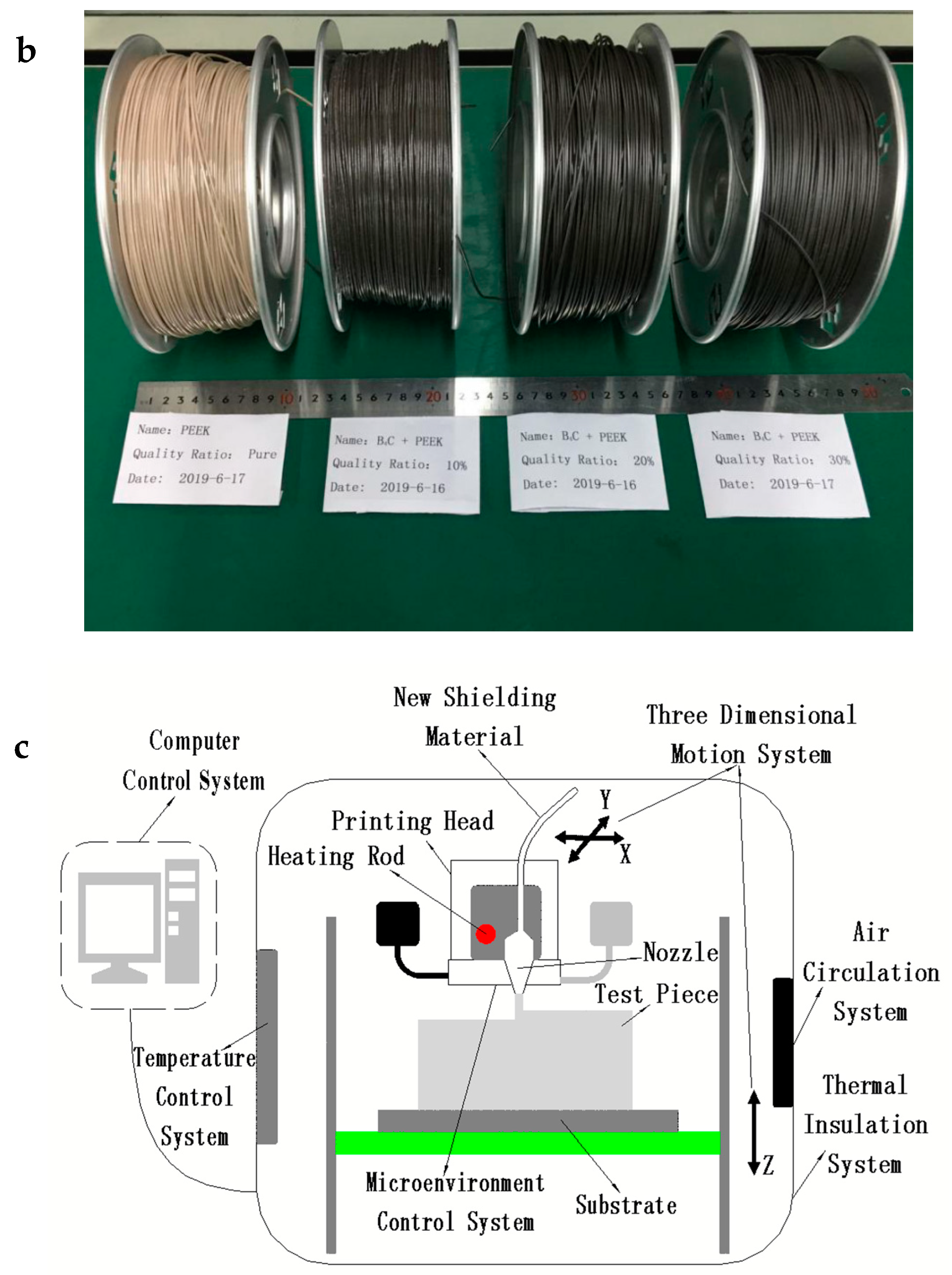
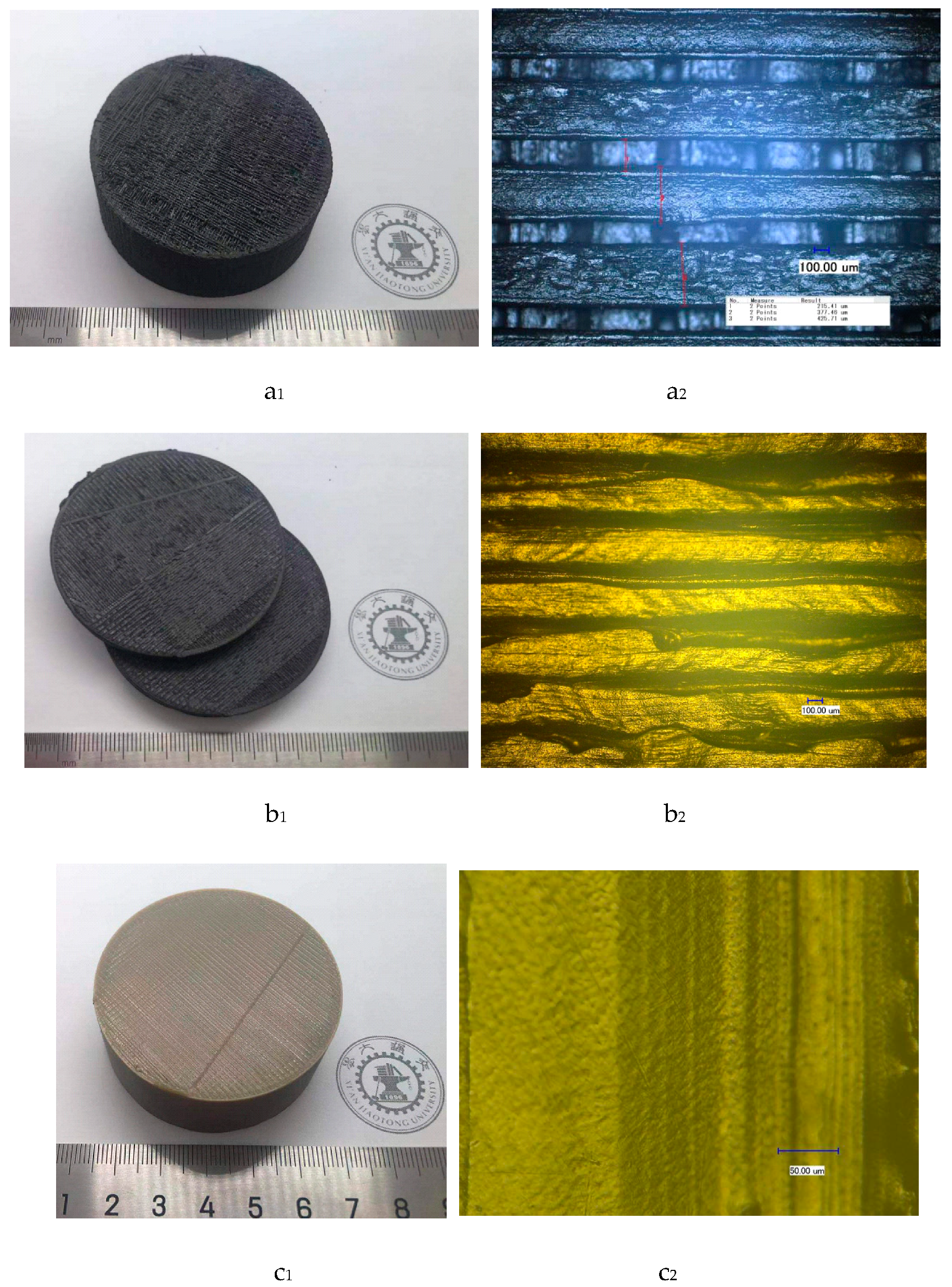
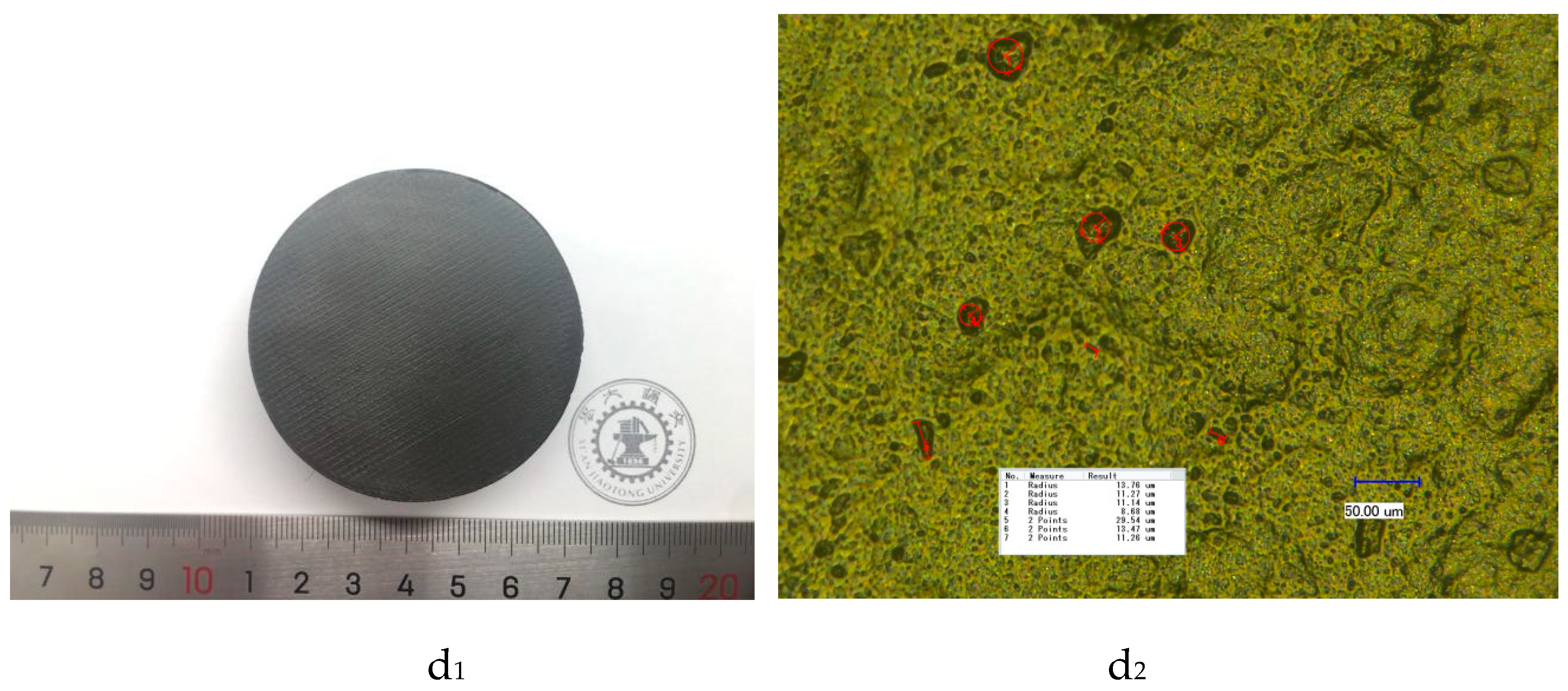
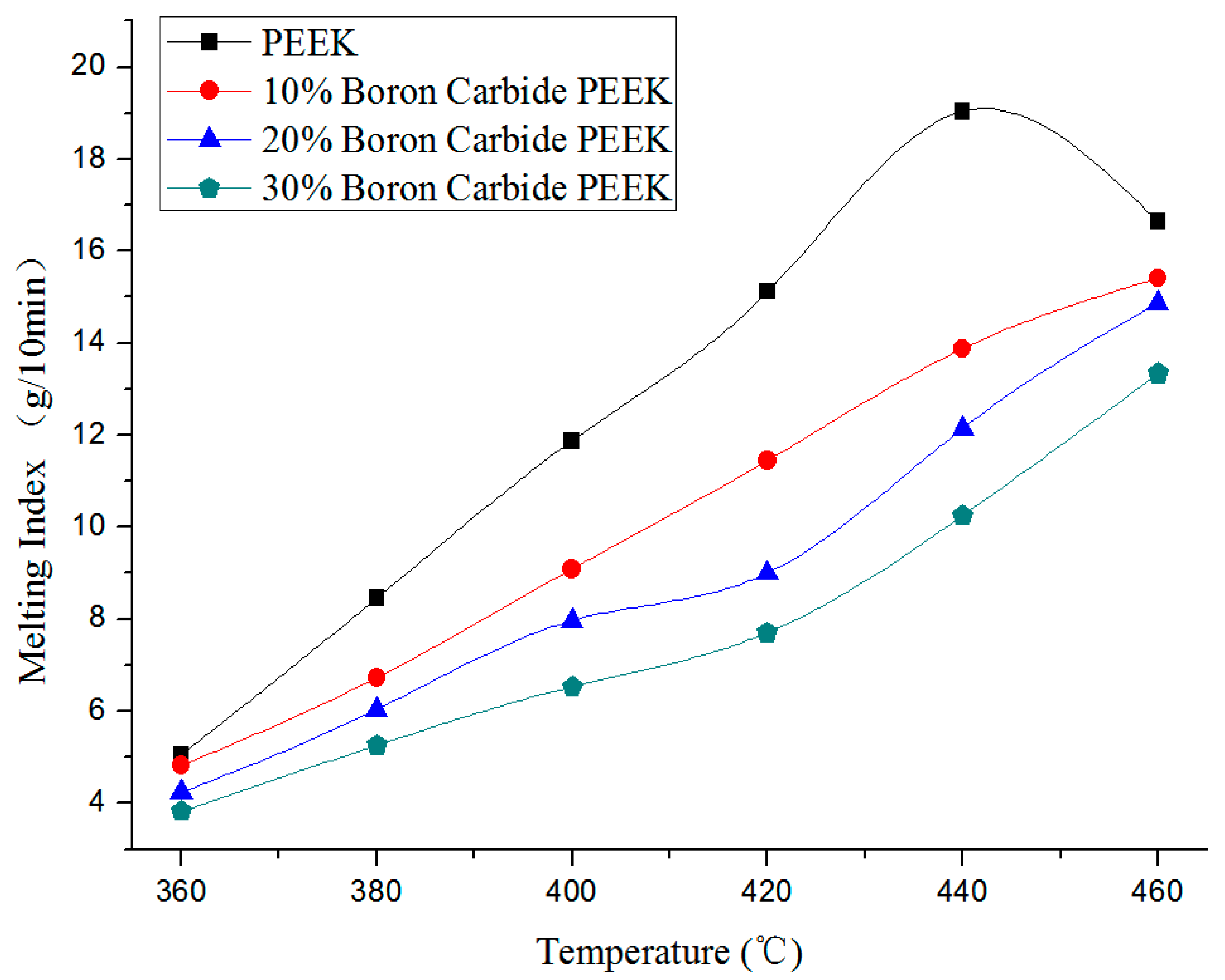
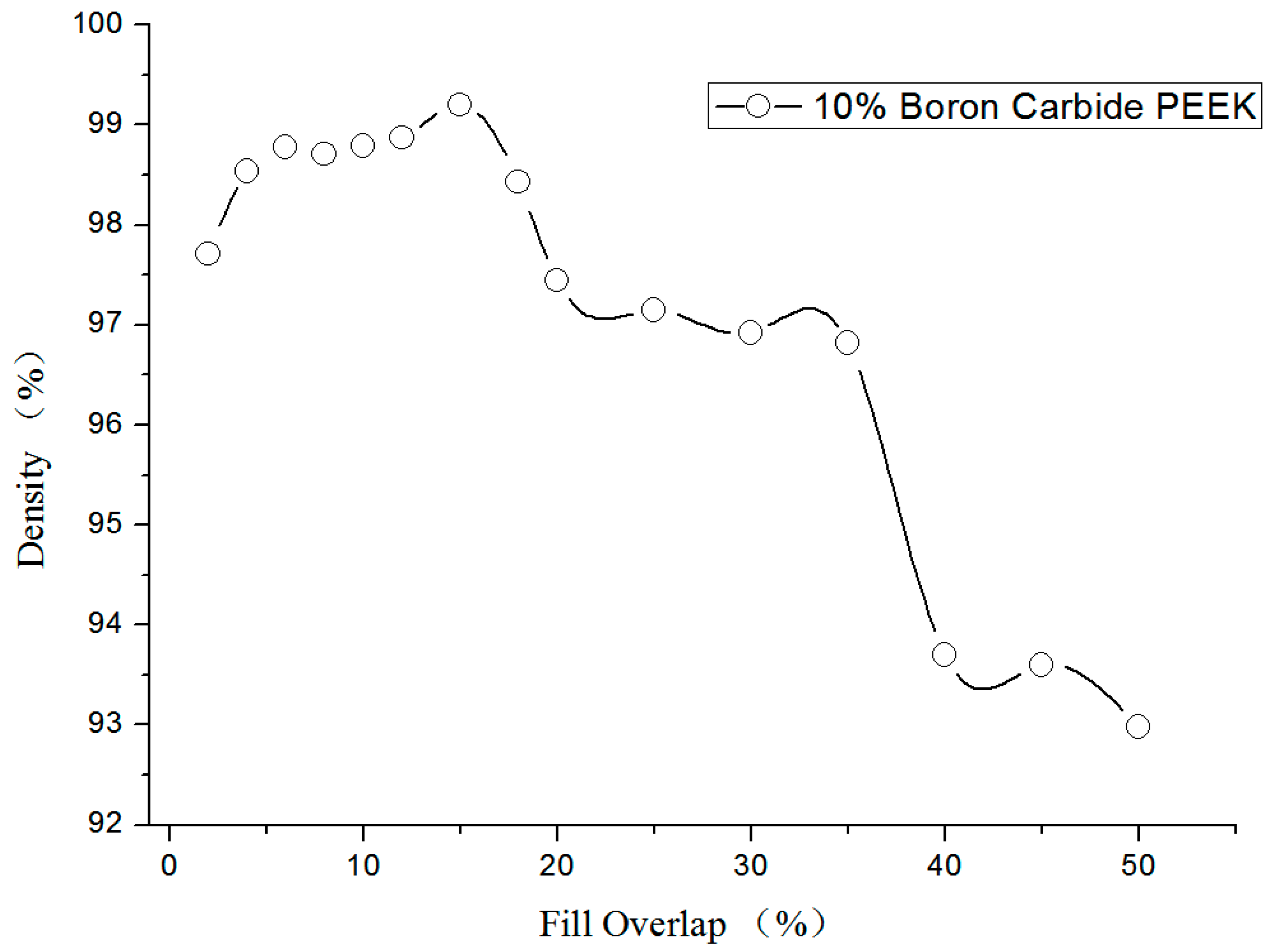
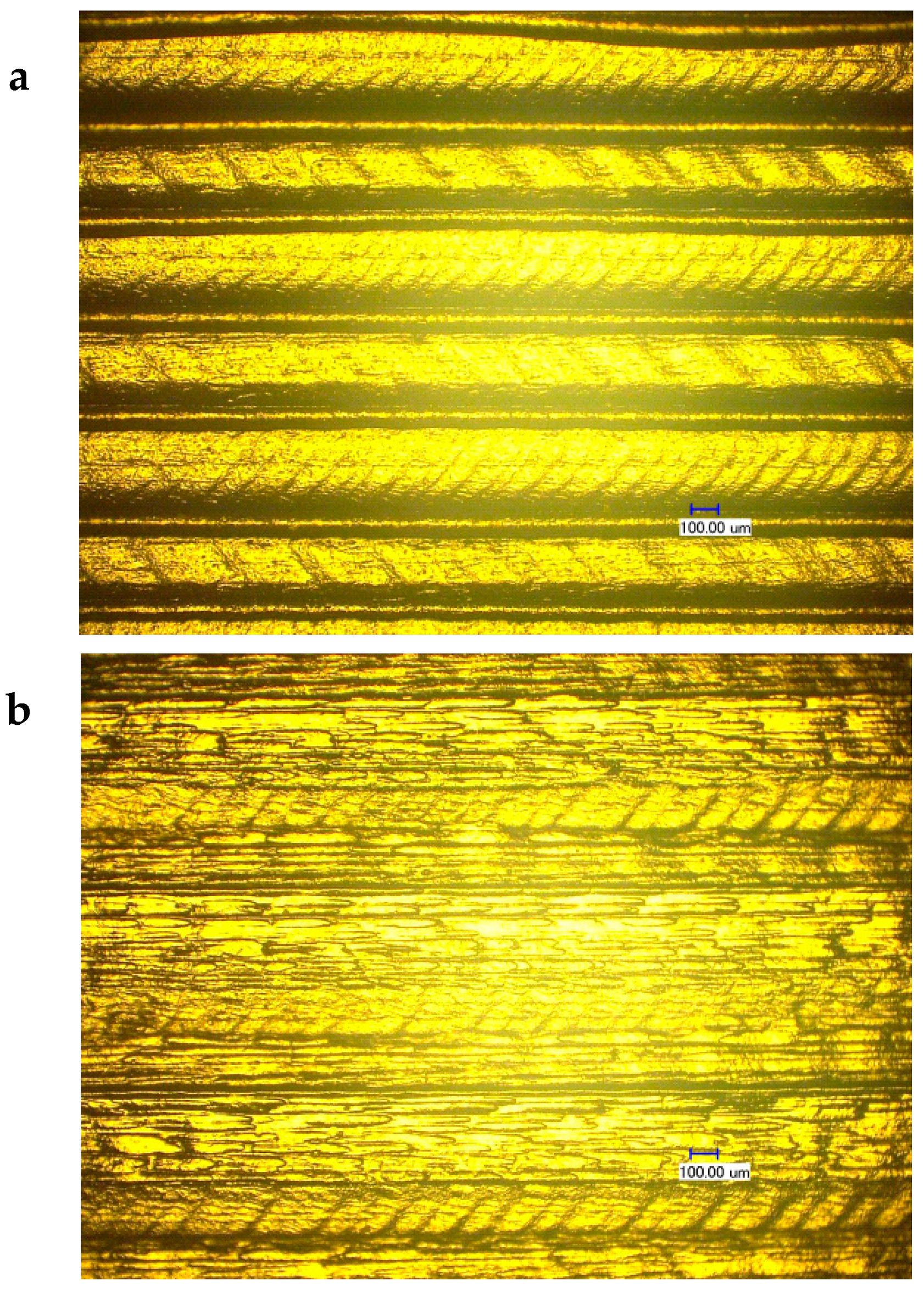
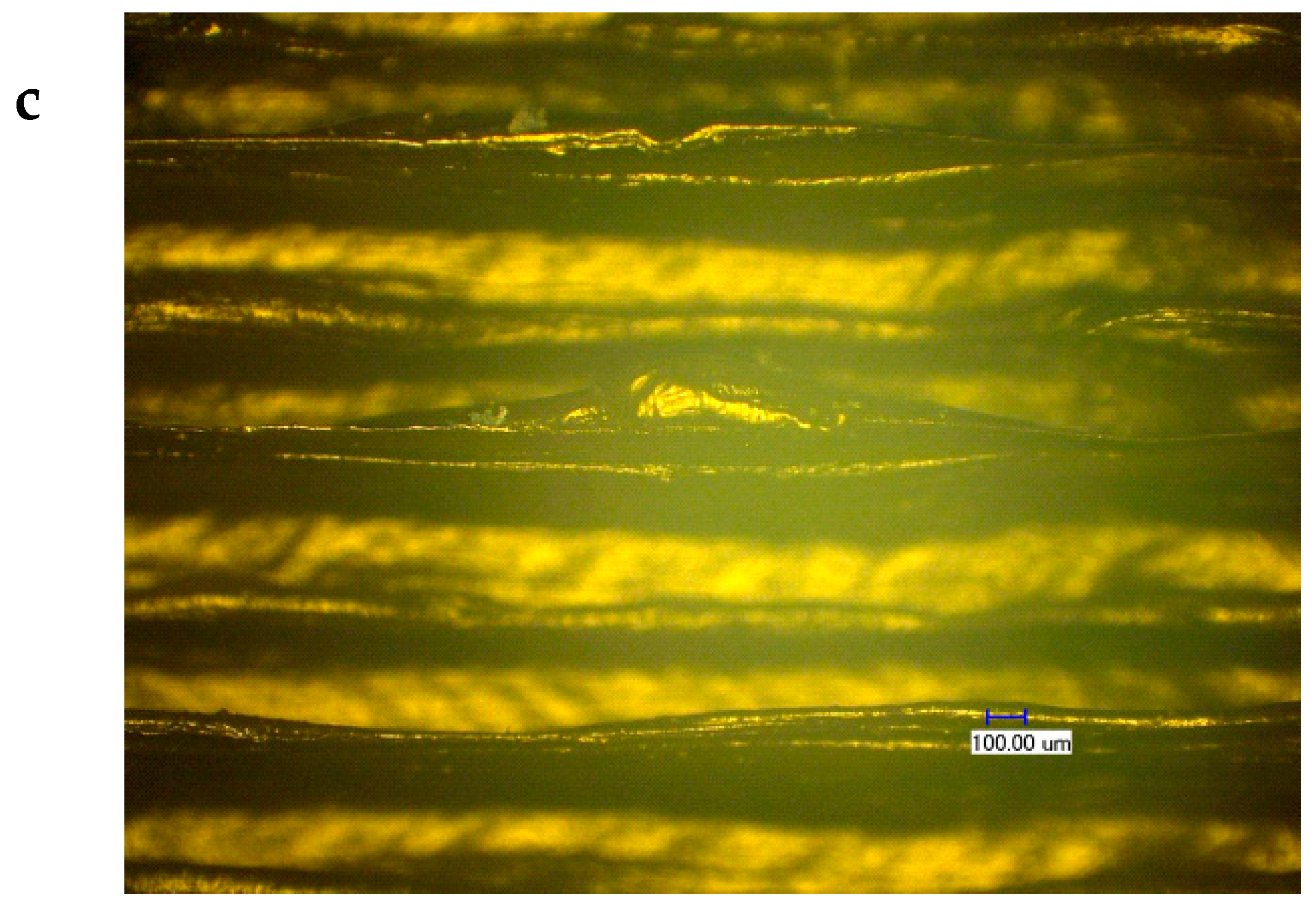
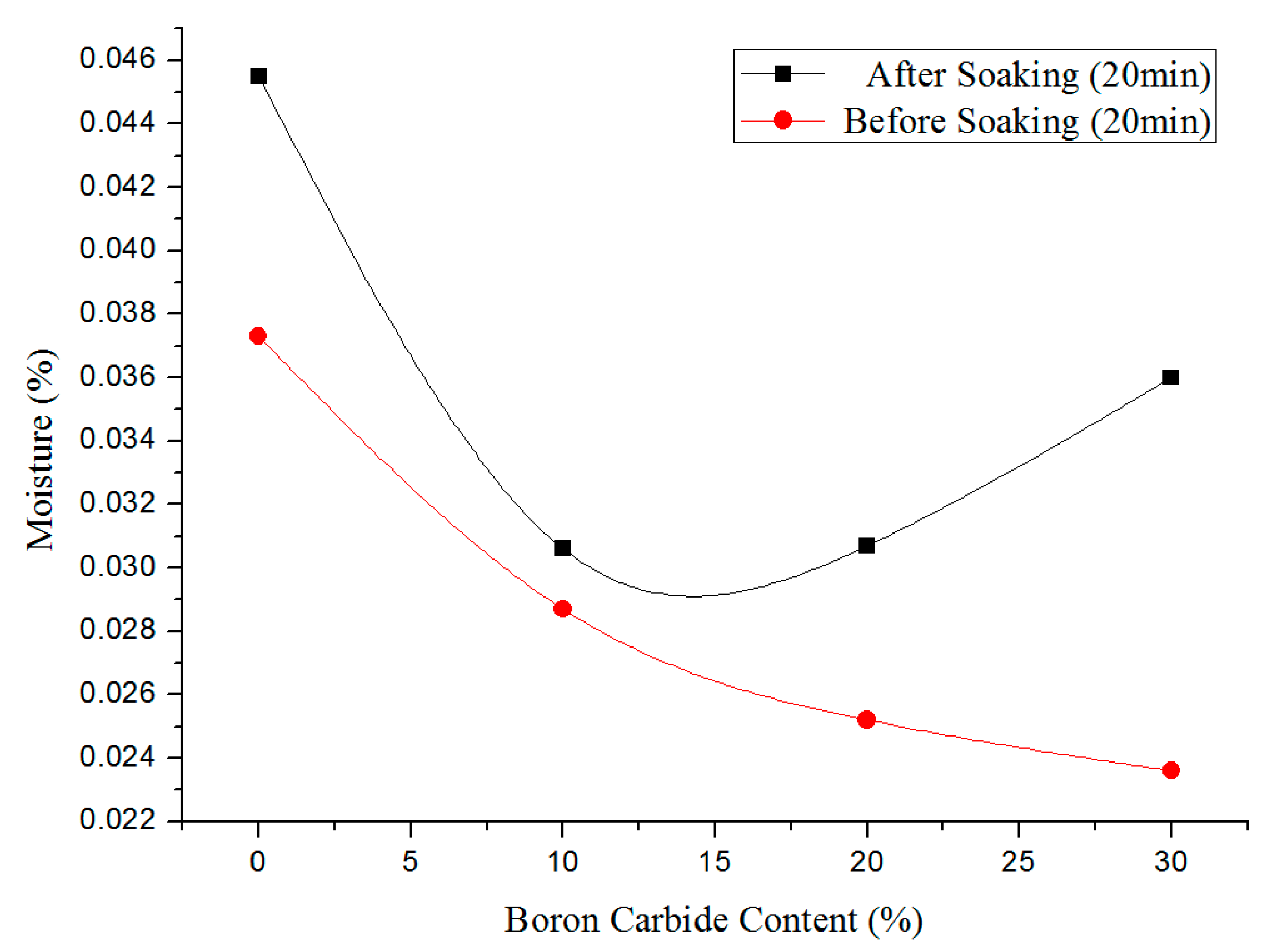
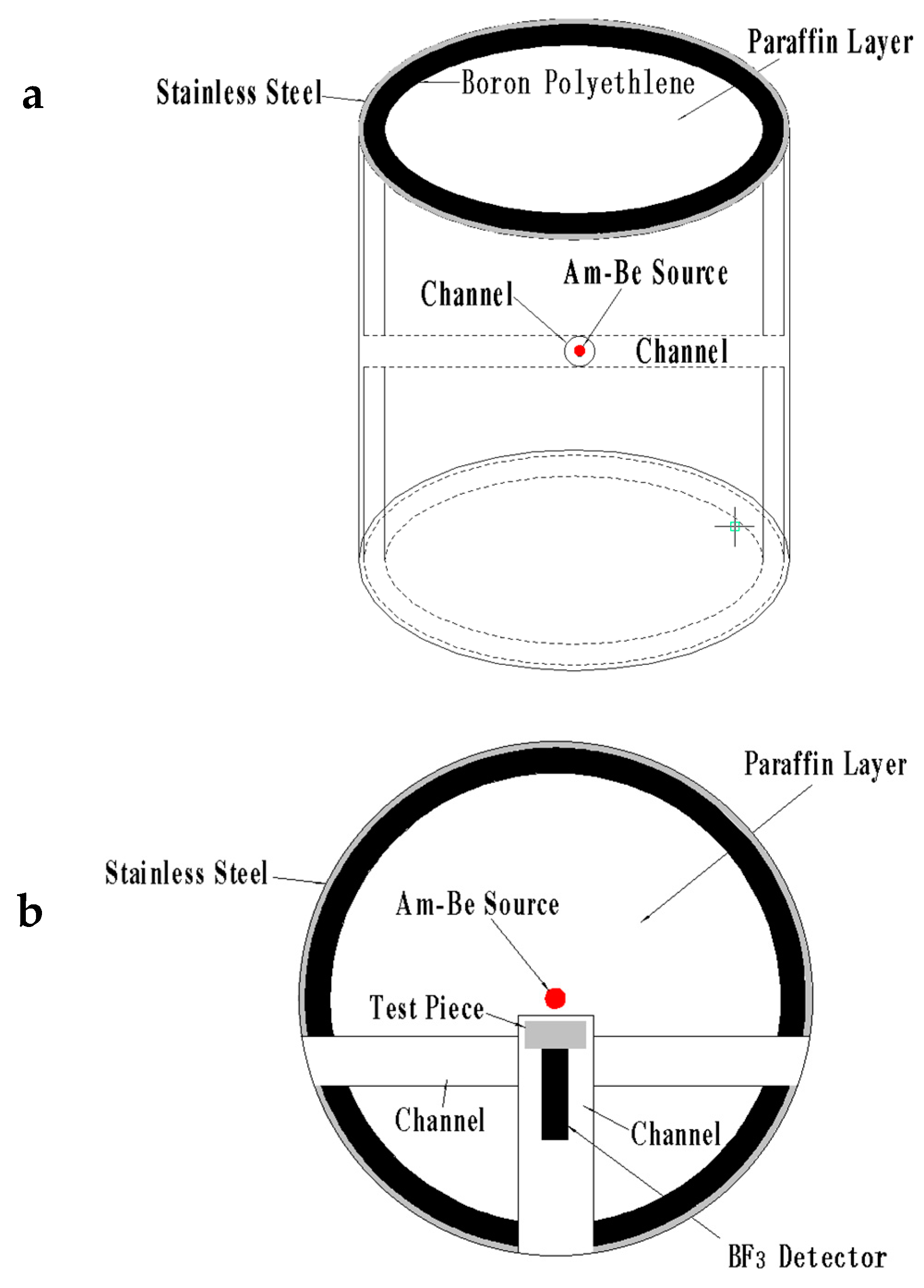

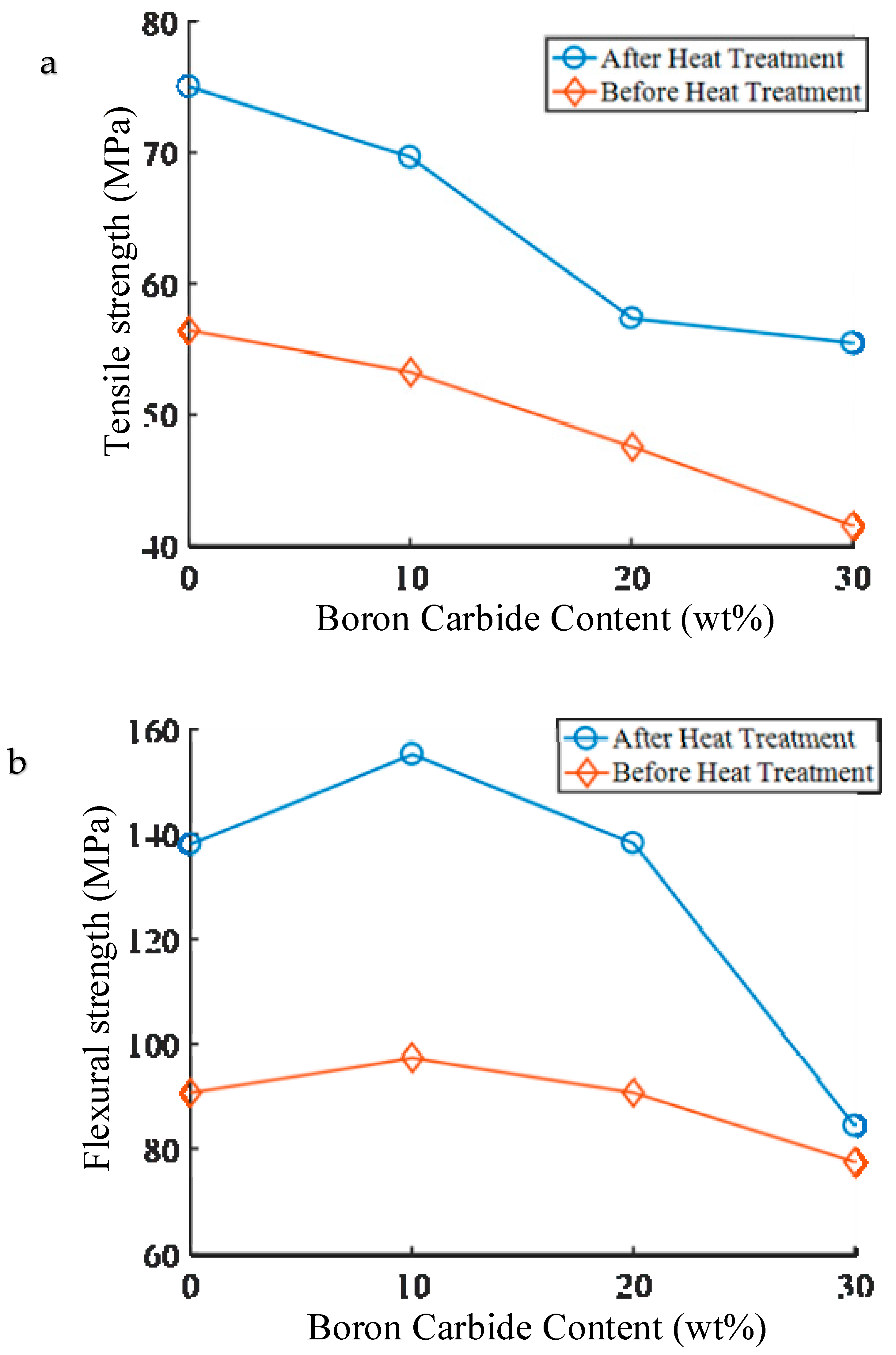
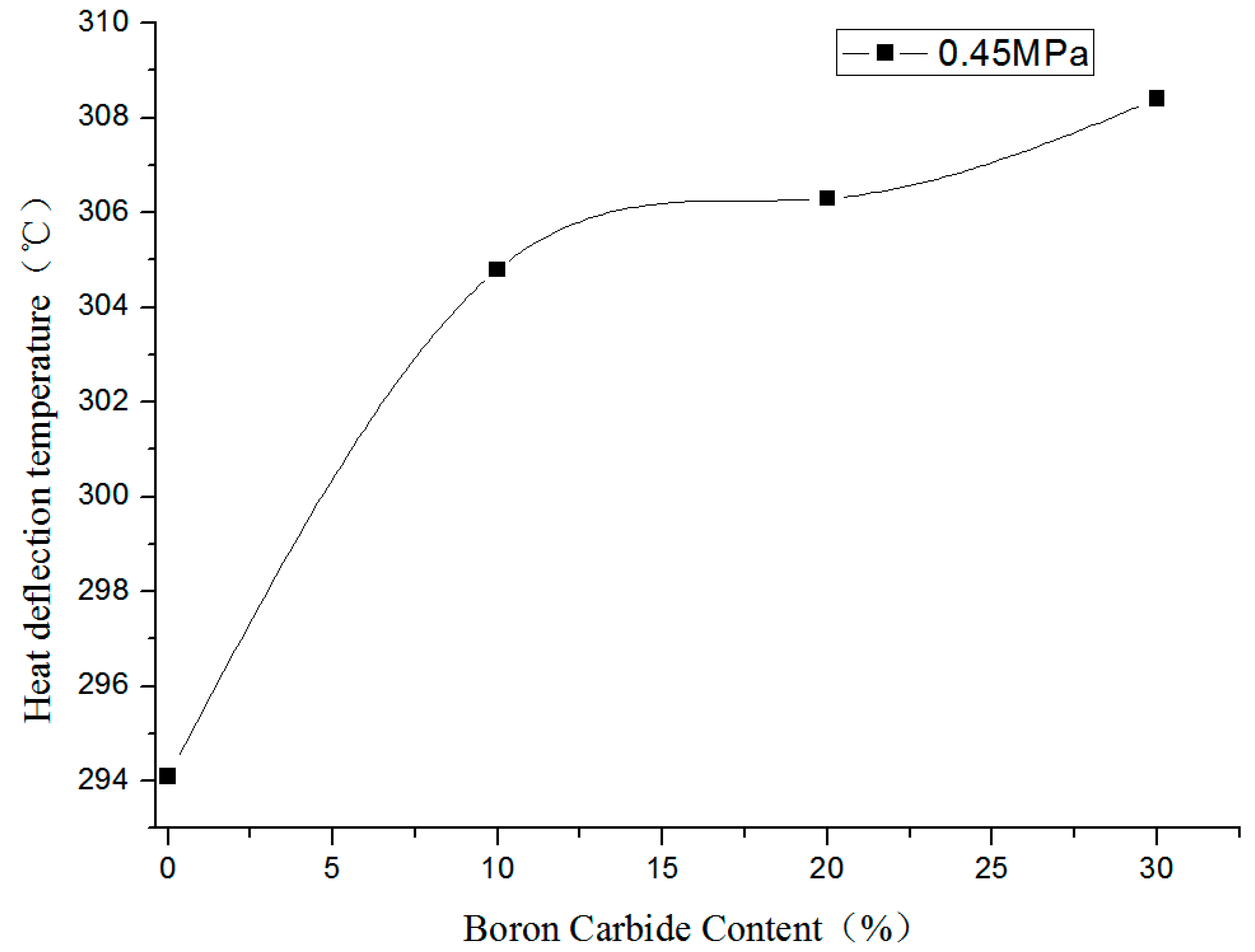
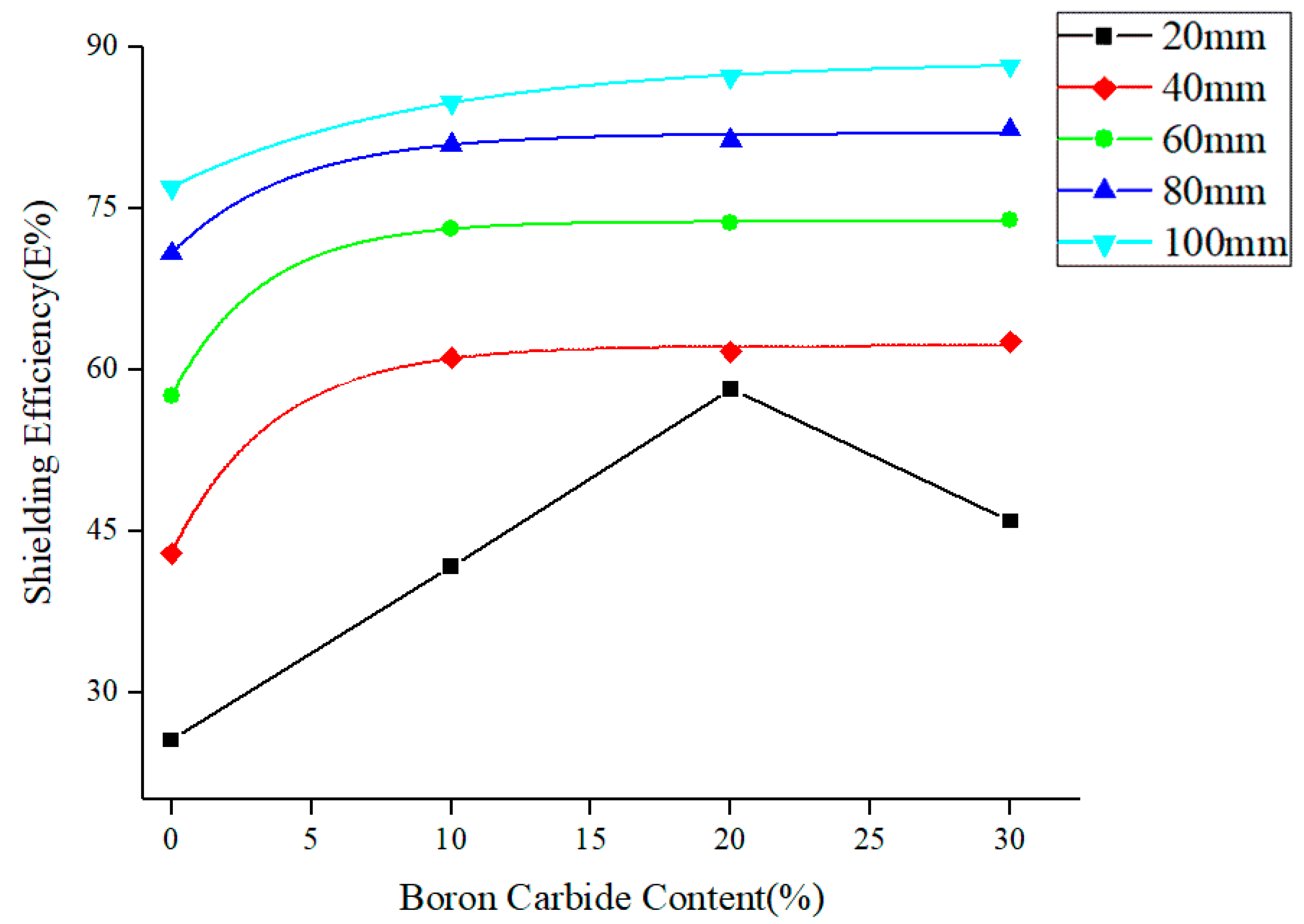
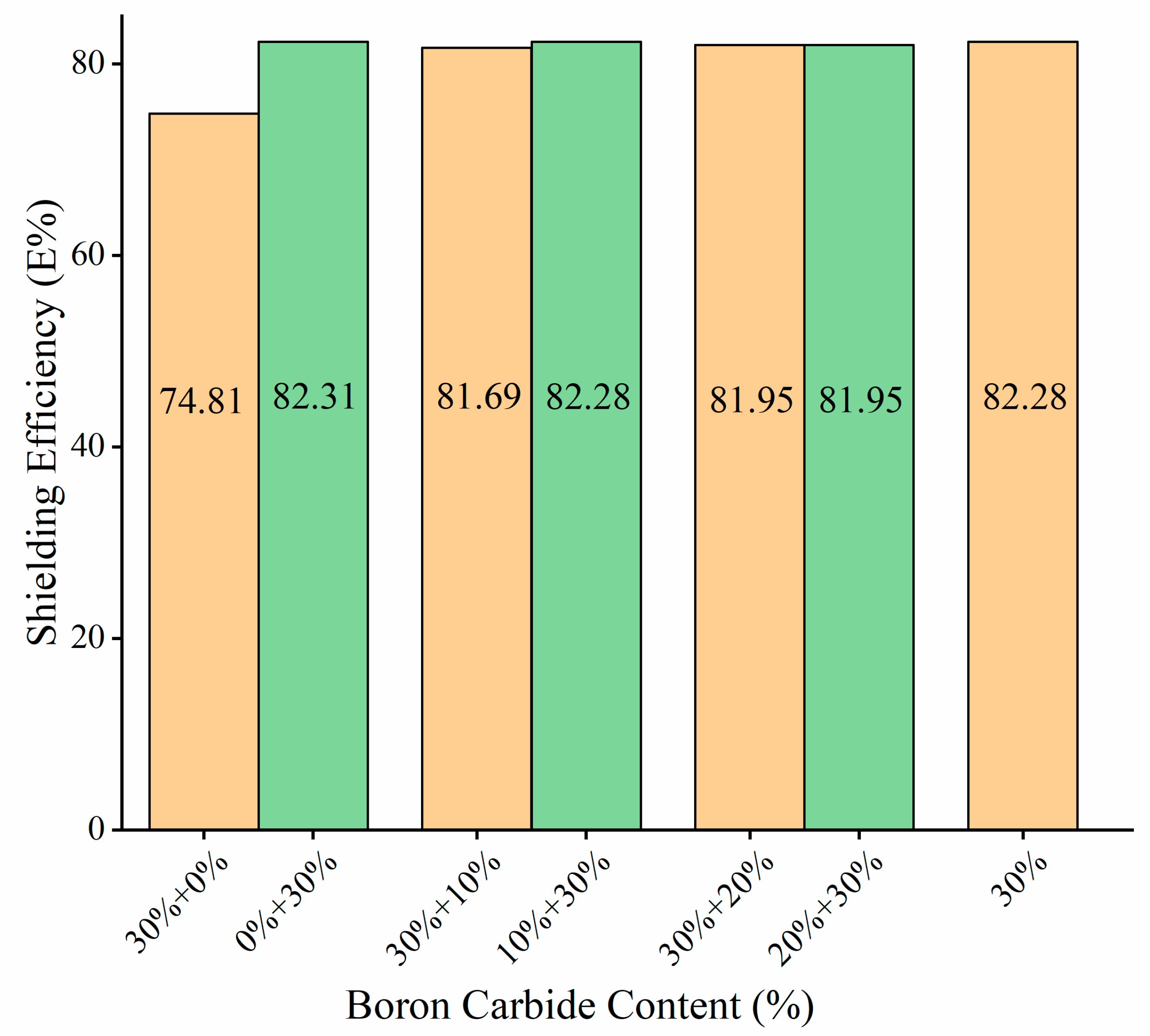

| Composites Name | Volume Ratio of Boron Carbide (vol.%) | Melting Index (g/10 min) | Printing temperature (°C) |
|---|---|---|---|
| PEEK | 0 | 13.00 | 410 °C |
| 10% wt. Boron Carbide PEEK | 5.62 | 11.00 | 425 °C |
| 20% wt. Boron Carbide PEEK | 11.81 | 10.40 | 435 °C |
| 30% wt. Boron Carbide PEEK | 18.67 | 9.80 | 440 °C |
| Composites Name | Nozzle Temperature (°C) | Nozzle Speed (mm/s) | Diameter of Print Nozzle (mm) | Line Width (mm) | Line-to-Line Overlapping Ratio |
|---|---|---|---|---|---|
| PEEK | 410 | 20 | 0.4 | 0.4 | 10% |
| 10% wt. Boron Carbide PEEK | 425 | 20 | 0.4 | 0.4 | 15% |
| 20% wt. Boron Carbide PEEK | 435 | 20 | 0.4 | 0.4 | 15% |
| 30% wt. Boron Carbide PEEK | 440 | 20 | 0.4 | 0.4 | 15% |
| Composites Name | Actual Wire Density (g/cm3) | Theoretical Wire Density (g/cm3) | Test Piece Density (g/cm3) | Wire Compactness | Test Piece Compactness |
|---|---|---|---|---|---|
| PEEK | 1.300 | 1.30(VICTREX) | 1.294 | 100% | 99.54% |
| 10% wt. Boron Carbide PEEK | 1.365 | 1.366 | 1.354 | 99.93% | 99.19% |
| 20% wt. Boron Carbide PEEK | 1.429 | 1.439 | 1.411 | 99.31% | 98.74% |
| 30% wt. Boron Carbide PEEK | 1.499 | 1.520 | 1.473 | 98.62% | 98.27% |
| Materials | Heat Deformation Temperature (GB/T 1634.2-2004) | Tensile Strength (GB/T 1040.2-2006) |
|---|---|---|
| VICTREX PEEK (FDM 3D Printing) | 294.1 °C | 75.08 MPa |
| 10% wt. Boron Carbide PEEK (FDM 3D Printing) | 304.8 °C | 69.68 MPa |
| 20% wt. Boron Carbide PEEK (FDM 3D Printing) | 306.3 °C | 57.40 MPa |
| 30% wt. Boron Carbide PEEK (FDM 3D Printing) | 308.4 °C | 55.45 MPa |
| High-density polyethylene 2911 produced by PetroChina Fushun Petrochemical Company (Injection Molding) [79] | 69.6 °C | 27.10 MPa |
| High-density polyethylene DMDA-8008 produced by PetroChina Dushanzi Petrochemical Company (Injection Molding) [79] | 73.7 °C | 24.80 MPa |
| High-density polyethylene C430 produced by Korea Samsung Total) (Injection Molding) [79] | 63.6 °C | 24.70 MPa |
| High-density polyethylene ME3500 produced by Korea LG Group (Injection Molding) [79] | 67.7 °C | 24.50 MPa |
© 2020 by the authors. Licensee MDPI, Basel, Switzerland. This article is an open access article distributed under the terms and conditions of the Creative Commons Attribution (CC BY) license (http://creativecommons.org/licenses/by/4.0/).
Share and Cite
Wu, Y.; Cao, Y.; Wu, Y.; Li, D. Neutron Shielding Performance of 3D-Printed Boron Carbide PEEK Composites. Materials 2020, 13, 2314. https://doi.org/10.3390/ma13102314
Wu Y, Cao Y, Wu Y, Li D. Neutron Shielding Performance of 3D-Printed Boron Carbide PEEK Composites. Materials. 2020; 13(10):2314. https://doi.org/10.3390/ma13102314
Chicago/Turabian StyleWu, Yin, Yi Cao, Ying Wu, and Dichen Li. 2020. "Neutron Shielding Performance of 3D-Printed Boron Carbide PEEK Composites" Materials 13, no. 10: 2314. https://doi.org/10.3390/ma13102314




